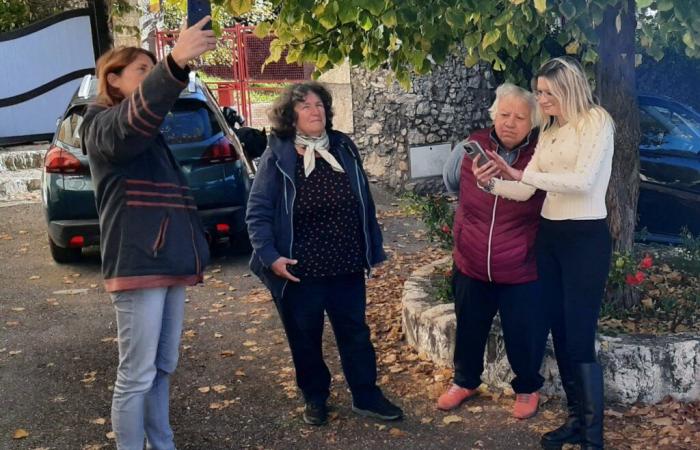
The phone rings and everyone in the square freezes. “Don’t tell me the network is back?” Crackling at the end of the line. Then silence. “False alarm. Still not working.” In Coursegoules, this sketch no longer surprises anyone and “doesn’t even disappoint anymore”. Since October 17, 2024, the village of 526 inhabitants has been without a mobile network. The powerful bad weather (which had motivated the prefecture to issue a red alert) got the better of the relay antenna, perched on a nearby hill. “Something must have broken. But why after a month nothing is resolved
ready? “, ask the residents together, immersed in a white zone. Without a landline, it is impossible for them to make a phone call.
“Even 112 doesn’t pass”
“On the screen, it says “Emergency calls only”but even that doesn’t work. » A dull anger vibrates in Marc Bertini’s voice. If “the inaction of operators” has until now inspired more weariness than revolt, the first deputy insists that a milestone has been reached. “We could have had a death”he growls, “This week, André had a heart problem in the middle of a fight. Impossible to call for help, even 112 doesn’t get through.” The hunter owes his survival only to the vivacity of his colleagues, who rushed off to fetch the firefighters from the fire and rescue center, located at the bottom of the village.
“You shouldn’t need help”summarizes Danièle Cartolano, busy in the kitchen where she prepares lunch for her “little mom”the dean. Born in 1929, Angèle Bonifacci doesn’t care about this network outage. The cell phone, “it’s not [son] thing”. “Still, it’s very practical to contact me if it falls.”grumbles her daughter.
If the village elders are not all lucky enough to have a caring Danièle at their side, they can still count on the spirit of solidarity that cements the rural community. To make up for the disappearance of telecommunications, we visit each other more often and we don’t miss the Thursday morning street market for anything.
“ The shortfall will be enormous.”
You don’t necessarily fill your basket: a few fruits or vegetables constitute a sufficient alibi for “do not remain isolated and come to the news”. Information which was quickly confused by contradictory rumors. No one really knows when the network will be back, fully restoring the daily life of the 21st century.
“We live like 20 years ago, without cell phones. Everything reminds us to what extent we have become dependent on this technology”muses Jean-Marc Testanier. After weighing a shopping bag, the merchant draws his electronic payment terminal. “With the little connection there is, let’s hope it works, otherwise we’ll have to pay in cash”he prefers to warn. The first deputy grimaces: “Except that people no longer have tickets and the first distributor is in Vence (…) November 23 is the Christmas market, the shortfall will be enormous.”
“Christmas, don’t talk to me about it”laughs Xavier Roux with a yellow laugh. The grocer is still waiting for his delivery of chocolates, ordered in anticipation of the end-of-year holidays. “With the GPS stopping working on the road and the impossibility of reaching me, the delivery men are turning around”regrets the merchant, his hands stuffed in the pockets of his large apron.
“Without being able to make an appointment, delivery has become more complicated”confirms Morgane Mero. The postwoman remains nonetheless enthusiastic, determined to live up to the mission entrusted by Santa Claus: “There are already the first orders for gifts. Even if my tour is longer, I go back and forth to make sure that everyone has been delivered. We all know each other in the village. We’re not going to see each other. drop.”
Use the wifi at the creperie or town hall
“Pancakes.” » In the Coursegoules creperie, as far away as it is from Brittany, the wifi code could not be called anything else. Easy to remember, practical when you have to connect several times a day to “get news from the outside world. For a month since there has been no mobile network, it has been impossible to do without wifi,” concedes Laurence Gourdon. But because some don’t have one, the manager makes her local wireless network available.
“The town hall has opened a room for college students who need the internet”
By connecting to it, regulars can call, send text messages and of course go on the internet. The operation can be done automatically but there is also a setting in the phone to ensure that it works. Despite everything, the wifi network loses efficiency when too many devices are connected to it.
“While waiting for telephony officials to decide to come to the village,” says mayor Dominique Trabaud, “the town hall has opened a room for middle school students who need the Internet for their homework, during school hours. opening of the town hall, and at the village library, also during its opening hours. »
Network restored by “Monday November 18 at the latest”
Damaged by bad weather on October 17, 2024, the relay antenna which serves Coursegoules should be repaired “Monday November 18, 2024 at the latest”, according to SFR, infrastructure manager on behalf of all mobile telephone operators . “Our teams intervened as soon as conditions permitted and noted the loss of technical equipment necessary for the proper functioning of the antenna,” explains the telecoms group. Before deploring that “the manufacturer of the parts concerned was not able to produce the spare parts within the usual deadlines. These are currently being delivered,” he finally assures, before inviting “the subscribers concerned to contact their customer service in order to obtain a commercial gesture”.





